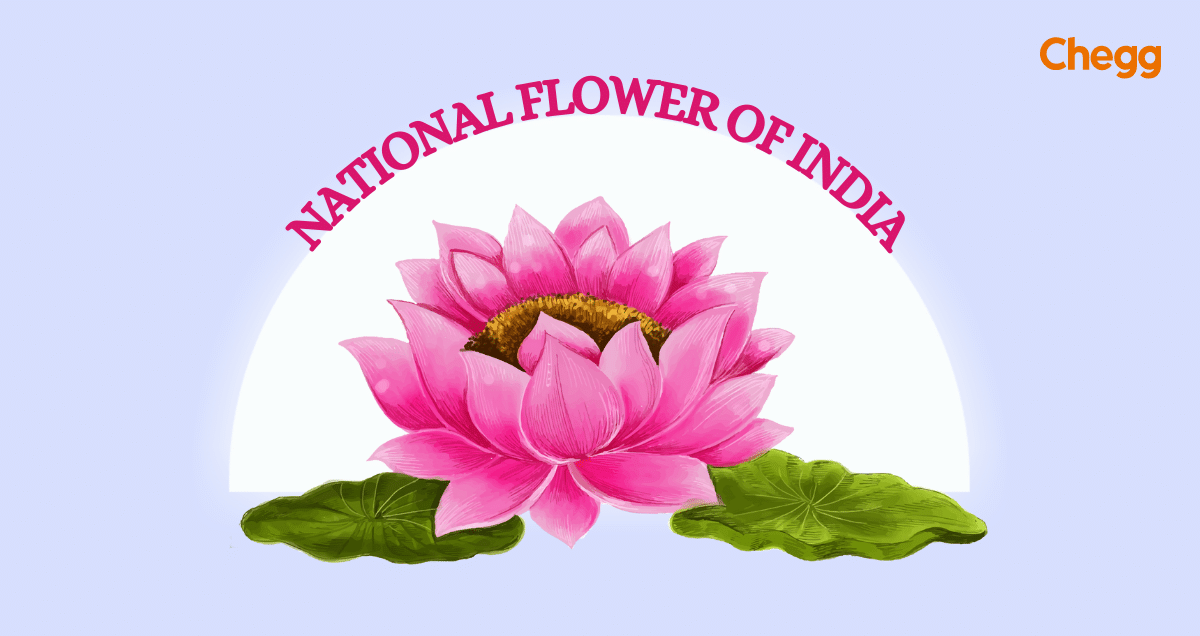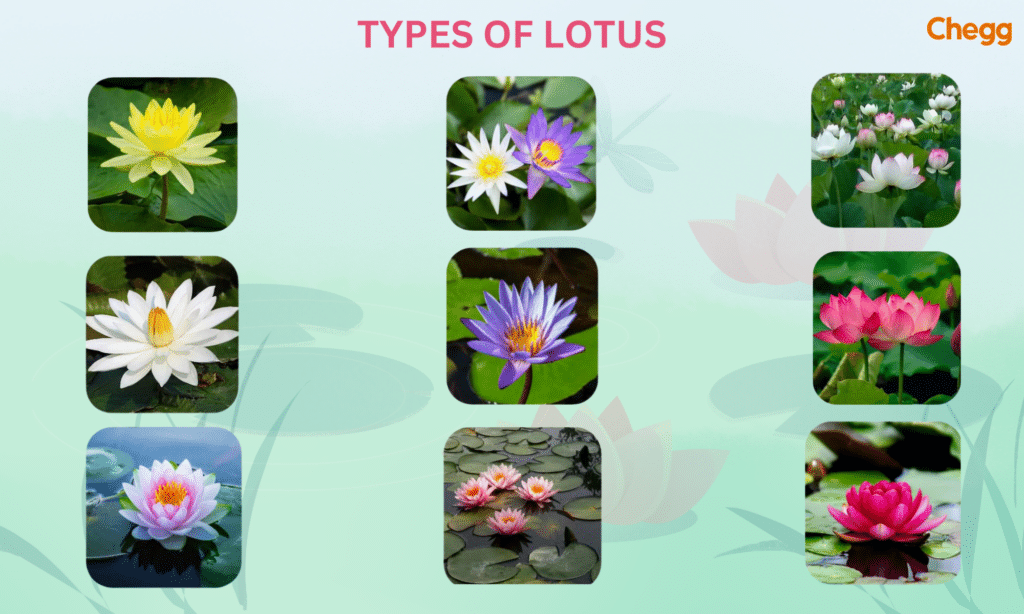National Flower of India: The Story Behind India's Beloved Lotus Flower


Quick Summary
- The national flower of India is Lotus, a member of the Nymphaea family of aquatic plants also known as the water lily.
- It symbolizes unity, wisdom, and resilience, reflecting India’s rich heritage and spiritual significance.
- The lotus has strong roots, floating leaves, pretty flowers, and grows in various colors and varieties.
Table of Contents
The National Flower of India is the Lotus. India’s national flower is the water lily, or lotus, a member of the Nymphaea family of aquatic plants. The broad, floating petals and symmetrically arranged petals of the large, eye-catching pink blossoms convey an air of elegance and tranquillity.
Since Hindus, who represent a significant percentage of the Indian population, hold them in high regard, plenty of legends, religious mythology, and folklore surround them. It is thought to represent victory, honor, longevity, and good fortune. Lotus is a symbol of survival and purity of heart, mind, and spirit in all situations. It can re-germinate for thousands of years and can live in both freshwater shallow waters and muddy wetlands.
Why is Lotus the National Flower of India?
The Lotus is a national flower of India, also known as the “water lily,” and is cherished as India’s favorite flower. It’s our national symbol because it carries a lot of meaning. This flower represents unity, and wisdom, and has strong moral values. People admire it not only for its beauty but also for its spiritual significance. The National Flower of India (Lotus) flower is often connected to gods and important figures in our ancient stories. The fact that it can grow so beautifully in muddy water symbolizes overcoming challenges and becoming better inside. This special flower plays a big role in our culture and history, reminding us of India’s rich heritage and the values we hold dear.
Significance and symbolism
The lotus is the National Flower of India because it’s a big part of our culture. It shows how purity can exist even when things are tough. Like the lotus can grow in muddy water, people can overcome problems and improve. The lotus’s pink petals opening up means we can grow spiritually and learn about ourselves. Learning about the lotus tells us a story of being strong, and changing, and how life’s different sides are connected.
When is the National Flower Day Celebrated in India and the World?
If you’re wondering, “When is National Flower Day in India?” or “When is the National Flower Day celebrated in the World” Actually, there are several celebrations held all year long. Every occasion showcases another aspect of the floral sector. It’s a festive and diverse celebration. Below is an explanation of various events:
- National Flower Day in India: India celebrates Flower Day on March 21. People can enjoy the splendor of national blooms thanks to it. It displays the distinctive flowers that have cultural significance in different countries.
- International Flower Day: January 19 is the International Flower Day. The world celebrates Flower Day on this day. It highlights how appealing they are to all people and how happy they make people feel.
- American Flowers Week: From June 28 to July 4, there is a week-long celebration, especially in the United States. It is committed to advancing and helping the US floral industry as well as regional flowers.
- Flower Day: The date of Flower Day is May 20. It’s an occasion to celebrate and enjoy the variety and color of the flowers that come with spring.
In talks about this holiday, the question “What is the national flower of India?” frequently comes up. Every country proudly names a particular flower that has symbolic, historical, or cultural value. This variety captures the complex range of floral appeal.
Japan, for instance, is famous for its cherry blossoms. The regal rose is a famous plant in England. The National Flower of India is the Lotus. We are invited to recognize the distinctive worth that every national flower carries on this day.
Lotus Flower Meaning: More Than Meets the Eye
The Lotus means much more than what our visions will ever witness. The national flower of India embodies an array of meanings across diverse cultures and contexts. Some of the critical meanings are:
- Purity – The lotus, thriving even in muddy waters, is a symbol of purity and finding spiritual enlightenment.
- Renewal and Rebirth – When the lotus opens and closes each day, it’s like a sign of starting fresh and being born again. It also reminds us that life keeps going in a never-ending cycle.
- Spiritual Awakening – Many people link the lotus to waking up to a higher understanding and discovering who we really are in spiritual beliefs.
- Transcendence – Going from the mud to the surface, the lotus tells us we can rise above tough times to find wisdom and enlightenment.
- Divinity – In lots of religions, you’ll see gods and goddesses sitting or standing on lotus flowers, showing how special it is.
- Beauty and Elegance – The lotus isn’t just pretty; it stands for grace, elegance, and a peaceful feeling.
- Growth – When the lotus starts as a tiny seed and grows into a full, beautiful flower, it’s a bit like how we grow in our lives and learn about ourselves.
- Harmony and Balance – With its roots in the mud and its lovely flower above the water, the lotus shows how things that seem different can come together, just like finding balance in our lives.
These meanings underline the lotus’s universal appeal as a potent emblem, resonating with transformation, spirituality, and the innate beauty of existence.
Biology and Characteristics of Lotus
The national flower of India does not hold significance merely because of its appealing beauty and grace. The flower also stands out as unique and different from others with its distinctive botanical features. The lotus flower, meaning water lily belonging to the Nelumbo species, showcases intriguing biological characteristics:
- Natural Home – Lotuses mostly grow in places with still water, like slow rivers and ponds.
- Roots That Hold On – These plants have roots that dig into the underwater ground, soaking up water and nutrients.
- Unique Leaves – The round leaves of the lotus sit on tall stems above the water. They can stay dry because they have tiny textures that push away water.
- Beautiful Flowers – Lotus flowers stand on tall stems and have layers of delicate petals, making them look like cups. They come in colors like white, pink, and yellow.
- Reproductive Mechanisms– Lotuses have both male and female parts for making more lotuses. Stamens are like male parts, and carpels are like female parts, helping them make seeds.
- Growing Up – After they make seeds, something interesting happens. The seed pods start underwater, but as they grow, they come up to the water’s surface.
- Spreading Seeds – When these pods are ready, they release seeds through small openings. These seeds have tough shells and can stay alive for a long time.
The Indian national flower seamlessly integrates aquatic adaptations, captivates aesthetics, and cultural symbolism, and emerges as a botanical marvel intricately woven into human heritage.
Cultural Insights on Our National Flower
The choice of the lotus as the national flower of India is profoundly rooted in cultural symbolism, carrying significant historical and spiritual meaning. This selection showcases the flower’s esteemed position within Indian culture, entwined with spiritual, artistic, and philosophical dimensions. The cultural significance of the national flower of India is:
- Inner Strength – Like the lotus coming from darkness to light, it’s like our journey inside ourselves to understand who we are. This means a lot in India’s spiritual history.
- Feeling Proud – When we say the lotus is India’s national flower, it makes people in India feel proud and connected to their culture.
- Many Together – The lotus symbolizes something that everyone can understand, showing how in India, even with many different cultures, there’s unity in our diversity.
Historical and religious connections
The lotus’s symbolism traverses religious boundaries, uniting people. It’s revered in Hinduism, Buddhism, Jainism, and other faiths, representing values diverse communities share. The national flower lotus is integral to ancient Indian texts and scriptures, woven into religious, literary, and historical narratives, underscoring its enduring cultural relevance. Indian mythology also often portrays the lotus as the seat of deities, amplifying its significance within divine contexts. Therefore, selecting the lotus as India’s national flower goes beyond its visual beauty. Its cultural richness, spiritual importance, and enduring influence on India’s heritage make it a fitting symbol of the country’s diverse culture and timeless principles.
Lotus Flower Information: Interesting Facts

The lotus flower information is far beyond its captivating beauty and spiritual qualities. Due to its symbolism encompassing purity, grace, fertility, self-regeneration, serenity, and divine attributes, our national flower is often positioned alongside revered deity figures. Much like other flowers, each lotus shade holds its distinct significance. The white lotus symbolizes purity and tranquility, while the yellow variant aligns with spiritual ascension.
The lotus’s extraordinary ability to rejuvenate itself in pristine splendor, facilitated by the protective waxy coating on its leaves that ensures its beauty is preserved each dawn, and its resolute refusal to succumb to defeat renders the lotus a symbol of unwavering faith.
Anatomy
1. Strong Roots – Lotus plants hold themselves in place with special roots that get nutrients from the mud underwater.
2. Floating Leaves – Lotus leaves are big, round, and waxy. They stay dry because they have air inside, so water can’t stick to them.
3. Pretty Flowers – Lotus flowers sit on tall stems above the water, and they look like cups made of many petals.
4. Reproduction – Lotus plants have both male (stamen) and female (carpel) parts for making more lotus plants.
5. Growing Seeds – The seed pods start growing underwater and then come up to the surface. When they’re ready, they let seeds out through small holes.
Colors
- Lotus
- Pink Lotus
- Blue Lotus
- Red Lotus
- Yellow Lotus
Varieties
- Nelumbo nucifera (Asian Lotus)
- Nelumbo lutea (American Lotus)
- Nelumbo komarovii (Chinese Lotus)
- Nelumbo nucifera var. thermalis (Sacred Lotus)
Uses
- Important in Religion and Culture – People use the lotus in religious events, art, and cultural celebrations because it has a deep meaning.
- Food and Medicine – In Asian cooking, they use lotus seeds and rhizomes because they’re good for you and taste good. Also, parts of the lotus plant are used in traditional medicine for health benefits.
- Beautifying Gardens – You can often see lotus plants in water gardens and ponds because they make them look more beautiful.
- Art and Writing– Lotus flowers are in paintings, sculptures, and books from different cultures around the world.
Lotus-inspired Art in India

The symbolic significance of the national flower of India, Lotus, has sparked creativity in art, poetry, and literature across diverse cultures. Its grace adorns paintings, sculptures, and architecture, often embodying purity and divinity. Employed metaphorically, it signifies beauty, growth, and transformation, evoking sensory impressions. The flower is also woven into myths and narratives. It imparts allegorical layers and embodies spiritual awakening. This enduring influence underscores the lotus’s universal appeal as a symbol of beauty, growth, and spiritual enlightenment.
Also Read:-
The National Tree of India: Banyan Tree
National Bird of India: An Overview
National Vegetable of India: Indian Pumpkin or Kaddu
Lotus and Indian Festivals: Blooms of Celebration
The national flower of India occupies a significant place in various Indian festivals, where its profound symbolism of purity, divinity, and spiritual awakening enriches cultural celebrations:
1. Diwali (Festival of Lights) – During Diwali, people use lotus designs for decoration. Lotuses represent purity, fitting with Diwali’s theme of bringing light to darkness.
2. Ganesh Chaturthi – Lord Ganesha, often seen sitting on a lotus, represents purity and good luck. The lotus symbol goes perfectly with Ganesha’s special qualities.
3. Navaratri – In Navratri, a festival honoring goddess Durga, people decorate with lotus flowers. The lotus is a symbol of divine femininity, which matches the respect for goddesses.
4. Buddha Purnima – During this festival celebrating Buddha, they use lotus flowers. The lotus shows how pure and wise Buddha’s teachings are.
5. Janmashtami – On Lord Krishna’s birthday, they use lotus designs for decorations. The lotus is a sign of Krishna’s special nature and wisdom.
6. Holi – The bright colors of the lotus give ideas for fun during Holi. The lotus’s colors fit in with the joyful atmosphere of the celebration.
Across these festivals, lotus flowers enrich celebrations by adding cultural depth.
Lotus Symbology in Other Cultures: Cross-Cultural Connections
There is more about the lotus flower than just a national symbol of India. Beyond India, the lotus flower holds diverse symbolic meanings in various cultures worldwide. Some of the countries that show great importance to our national flower are:
- Egypt – In ancient Egypt, the lotus symbolized rebirth, like the sun rising every day. It was linked to the Nile River’s annual flood, which brought prosperity.
- China – In China, they love the lotus because it grows in muddy places but has beautiful flowers. It stands for being pure, wise, and growing inside.
- Japan – In Japan, the lotus means being pure, wise, and strong when you face problems. They link it to Kannon, a kind goddess.
- Tibet – In Tibet, the lotus growing from mud to a pretty flower shows how we can get better inside. They use it in drawings to show being pure and rising above challenges.
- Ancient Greece – In old Greece, the lotus was about feeling young again. They thought it could make you feel better, like in the story of the lotus-eaters.
- Vietnam – Besides India, Vietnam also loves the lotus. It means beauty, purity, and trying to grow inside even when things are tough.
Across these cultures, the lotus flower’s universal appeal as a symbol of purity, enlightenment, and growth underscores its timeless significance in the human narrative.
Conclusion: The Everlasting Allure of India’s Beloved Flower
Deeply ingrained in India’s cultural tapestry, the lotus flower goes beyond its botanical nature to embody the essence of the nation’s values. Its symbolic journey from murky depths to pristine surfaces mirrors India’s resilience, pursuit of purity, and spiritual enlightenment. As the national flower of India, it unites a diverse nation, symbolizing hope, resilience, and the enduring quest for higher truths. Just as the lotus remains untainted amid impurities, India’s affinity for it reflects the nation’s unwavering self-belief. It represents a nation that finds strength in unity, upholds its ideals, and continually evolves while preserving its core identity. The lotus, much like India’s journey, reminds us that challenges can lead to growth and transformation, even in the most challenging circumstances.
Frequently Asked Questions ( FAQ’s )
What is the national flower of India?
The lotus is the national flower of India.
Why is the lotus our national flower?
The lotus was chosen as India’s national flower due to its deep-rooted cultural significance, and spiritual symbolism.
What does the golden lotus signify in Buddhism?
In Buddhism, the golden lotus signifies enlightenment, spiritual purity, and divine wisdom.
In which environment can the lotus survive?
The lotus or the “water lily” can survive in fresh, muddy water environments.
Why is the lotus flower considered sacred?
The lotus flower holds sacred importance because of its purity, hope, resilience, and spiritual development.
Got a question on this topic?